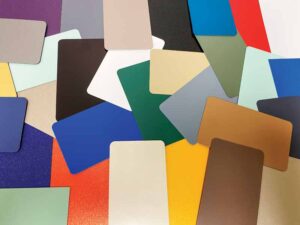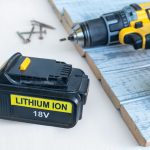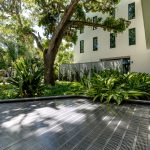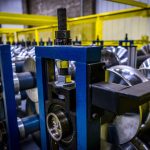
Choosing finishes for commercial buildings’ aluminum-framed vertical fenestration assemblies—windows, curtain curtainwalls, (one word), storefronts, and entrances—often begins by selecting a color. Specialty coatings can also enhance the visual and tactile effects of the finished appearance.
Since fenestration products have both interior- and exterior-facing finished surfaces, high-performance coatings are typically required to ensure lasting performance with minimal maintenance. An experienced finishing services provider can assist with evaluating the optimal finish to meet performance specifications’ inside and out—and support a building project’s aesthetic, sustainability, and longevity goals.
Aesthetic options for colors and visual effects
Appearance usually is the first consideration when selecting a finish for architectural aluminum fenestration. With one glance, color can establish a mood, convey information, or reinforce a brand.
Color trends
Architectural design color trends for 2024 include softly tinted hues that reflect warmer, less saturated colors. These colors are intended to soothe and inspire, conveying a sense of comfort, peace, and wellbeing.
- The dark bronze and pale aubergine tones of 2023 gave way in 2024 to chocolatey browns, honey beiges, violet-tinged blue-grays, and peachy pinks. Distinctive as individual colors, they also harmonize well to present tranquil, creative, expressive designs.
- Rooted garden greens add biophilic inspiration to the built environment. Greens commonly denote peace and tranquility, demonstrating health and connection to the natural world. Subtle muted gray-greens inspired by the Earth’s forests, such as lichen and conifer, bring a familiar comforting presence. Compelling blue-greens and dark teals are a calming choice for reflection and renewal.
- Light natural neutrals—such as unbleached cotton, oat, and bone—unify the framework that connects the built and natural environments. Buttermilk, straw, and chamomile yellows elicit joy and brighten with ease. Unsaturated tans and whites offer an elegant choice. Integrating light neutrals into exterior-facing components present a welcoming and adaptable appearance.
- Floral pinks and spicy reds complement and accent the 2024 palette. Earth-aligned browns, reminiscent of stone, soil, and terra cotta clay, mix in red and purple to generate an atmosphere of groundedness and balance.
Special effects
Experienced finishing service providers can combine scientifically precise color matching, in-house blending laboratory capabilities, and quality-controlled factory application with hands-on artistry for tailor-made solutions. Specialty coatings can include mica and metallic flakes to enhance reflectivity, adding sparkle and shimmer to the base color. Beyond the traditional color wheel, specialty painted finishes can impart texture and depth, and be completely customized to support project specifications.
Softly textured painted surfaces expand the sensory experience from visual to tactile, and present a biophilic element not often seen on fenestration framing. Typically used to mimic the feel of natural stone, such as terra cotta, textured coatings on architectural aluminum products offer an economical, readily available, lighter weight, and more resilient alternative to the clay-based originals. The fine grain, matte surface of these specialty finishes remains consistent in texture, while colors have a full range of hues representing the spectrum of true terra cotta.
Multi-colored spattercoat finishes can also realistically simulate the look of marble, masonry, and metal, or can provide a completely novel appearance resembling the style of abstract and impressionist fine artists. To achieve the desired aesthetic, multiple colors of architectural coatings are applied on top of a solid undercoat in a hand-crafted original pattern. The paint spatters can be many or few, large or small, thick or thin, speckled or swirled to produce the desired three-dimensional depth and textured effect.
Color code
Painted finishes can provide a nearly unlimited color range for fenestration. To achieve the desired finish color, use the assigned paint code provided by either the coatings system manufacturer or the finishing applicator. Paint and finishing codes are usually composed of both letters and numbers. As with passwords and other important information, one incorrect number or letter within a code can completely change
the result.
Color names like Sierra Tan, for example, may be easier to remember and more illustrative than LT621, but relying on color names can be a risk. Two paints with the same name can be completely different colors depending on the manufacturer. For instance, Hartford Green could serve as the name for at least 50 different paint codes. Therefore, it is important to use paint codes over color names.
Remember to check, and double check, that the paint code is correct. This code can be included in the specification and will be needed for the final order.
Sample review
When color is critical, review a physical sample to confirm client approval before placing the order. Remember the same color can look different in changing light or when placed next to other colors and materials. People see color slightly differently depending on the number of photoreceptors on their retinas and how their brains interpret the optical signals.
With fenestration, the glass selection will have the most influence on how the framing members’ finish is perceived. Pair these samples together for optimal results.
Interior surfaces of finished fenestration are best reviewed indoors using a combination of natural and electrical illumination. Vertical fenestration assemblies are installed at the exterior perimeter, positioned offset and perpendicular to suspended light fixtures. Lamps and task lighting may directly affect, and be affected by, the fenestration assembly. A light’s angle, lumens, color temperature, and surface reflections can also alter the perceived color of room-facing finished surfaces. When possible, consider replicating the lighting conditions to examine the finished samples.
Exterior-facing finished surfaces should be reviewed outdoors under natural light. The larger the painted area, the more noticeable variation can be, even when the coating is uniformly applied. This is especially true for specialty coatings with metallic and mica coatings because the color depends on the orientation of the reflective flakes. For example, a 1 x 3-m (3.3 x 9.8-ft) wall panel’s color may appear inconsistent when compared to other finished surfaces on the same building at different times of the day or when illuminated at night.
Viewing distance also affects the perceived color. The finish on a curtainwall with a
63.5-mm (2.5-in.) sight line may look different when viewed at a shaded street level than it does looking up at the 20th floor on a sunny day. When evaluating the finished, installed fenestration assembly, American Architectural Manufacturers Association (AAMA) industry viewing distance guidelines state that coatings should be visibly free from flow lines, streaks, blisters, or other surface imperfections in the dry-film state
on exposed surfaces when observed at 3 m (10 ft) from the metal surface and inspected at a 90-degree angle to the surface.
PVDF resin-based paint composition
Paint coatings may be described as a thin layer of film containing resin and pigments that is applied to a material’s surface to provide protection and a decorative appearance. The resin system determines the performance and properties of the painted finish, and the pigment provides the color.
For more than 50 years, polyvinylidene fluoride (PVDF) resin systems have demonstrated consistent, reliable performance for aluminum-framed fenestration. The percentage of the resin component defines the coating’s designation. For example, a 70 percent PVDF resin-based paint coating formulation contains 70 to 80 percent by weight PVDF in the coating binder (or resin), with the remainder of the binder being a compatible acrylic. Although the acrylics are used in relatively small quantities—typically 20 to 30 percent by weight—they can improve the coatings’ pigment wetting and adhesion properties. In this way, the acrylic properties complement the highly inert PVDF.
In liquid paints, the resin accounts for approximately 20 percent, the pigment 10 percent, and the liquid solvent used to deliver the paint represents up to 70 percent of the total coating system. A small percentage of reducer and additive components may also be included to adjust viscosity, enhance gloss, or impart other characteristics.
PVDF resin-based architectural coatings for fenestration are specified as either 50 percent PVDF or 70 percent PVDF. Occasionally, a paint resin or coating system manufacturer’s brand name may be mistakenly used as a specification.
As standard, PVDF architectural coatings for fenestration typically are two-coat systems that include a primer and the color coat. Three- or four-coat systems may be used for specialty colors and metallics. Typically, the paint code will have a numerical identifier indicating the number of coats and whether a clear topcoat is need. Adding a clear coat to a paint finish when it is not required will not add value to the finish and may add unnecessary cost.
Factory-finish process and environmental considerations
Extruded aluminum framing is the most specified material for fenestration assemblies on commercial buildings. Aluminum is infinitely recyclable, widely available, and relatively easy to form and fabricate into windows, curtainwalls, storefronts, and entrances. Aluminum’s light weight makes it economical for shipping, and versatile for installing either as pre-assembled products or as field-assembled systems.
Before fenestration products arrive at the jobsite, they are finished under factory-controlled conditions to uphold the specified performance and warranty requirements. For complete coating coverage, an electrostatic spray application production line is used for architectural aluminum extrusions, flat sheets, and fabricated parts.
To ensure strong adhesion, the metal is first cleaned, pretreated, rinsed, and dried. After pretreatment, the material falling within certain size parameters is racked onto a carrier system and moved through the liquid paint finishing line. Oversized material requires off-line finishing, which can add extra time and cost.
Once the paint is applied to the aluminum, the solvent’s function is complete. Since some of the solvents used are considered volatile organic compounds (VOCs), they must be carefully managed within the finishing facility. Responsible liquid paint coating applicators use a 100 percent air capture system with a regenerative thermal oxidizer to carefully capture and safely destroy the VOCs, repurposing their energy within the factory. This process ensures there is no adverse environmental impact, and no VOC-related health risk for the product installer, building owner, or occupants.
Before it leaves the factory, the coated and racked material moves to the curing ovens where it is closely monitored to reach peak metal temperature. For proper cure of 70 percent PVDF resin-based coatings, the finished aluminum must reach approximately 232 C (450 F) for at least 10 minutes depending on the material’s thickness and each paint coating’s specific specifications.
Quality assurance tests, coupled with reducing material handling through automation, allow for an efficient, uniform, consistent coating application. Large finishing service providers invest in automated conveyer carriers, numerous spray booths with rotary atomization bells, and control panels. Automating these processes and color changes conserves paint, reduces waste, improves quality, and fulfills the order accurately and quickly.
Specification guidelines for performance and durability
The Fenestration and Glazing Industry Alliance (FGIA) publishes three industry standard specifications for architectural coatings on aluminum extrusions. These widely referenced documents were updated in 2022.
- AAMA 2603-22, Voluntary Specification, Performance Requirements and Test Procedures for Pigmented Organic Coatings on Aluminum Extrusions and Panels (with Coil Coating Appendix), provides the least stringent specification, pertaining to one-coat baked enamel coatings without a primer. It usually is reserved for interior applications.
- AAMA 2604-22, Voluntary Specification, Performance Requirements and Test Procedures for High Performance Organic Coatings on Aluminum Extrusions and Panels (with Coil Coating Appendix), provides intermediate performance, pertaining to 50 percent PVDF resin-based, two-coat systems with a primer and a color coat. The resulting finish offers good color and gloss retention, hardness, and abrasion resistance suitable for storefronts, entrances, and other high-traffic areas.
- AAMA 2605-22, Voluntary Specification, Performance Requirements and Test Procedures for Superior Performing Organic Coatings on Aluminum Extrusions and Panels (with Coil Coating Appendix), provides the highest performance, pertaining to 70 percent PVDF resin-based coatings. This includes two-coat systems, and three-coat and four-coat systems for metallic and exotic colors that require a clear topcoat and sometimes, a barrier coat. The resulting finish offers outstanding color and gloss retention, hardness, and abrasion resistance, suitable for curtainwall and monumental architectural projects.
High performance and warranty considerations
Finishes that meet AAMA 2605 exhibit exceptional durability and resistance to humidity, color change, chalking, and chemicals. They perform as specified when exposed to UV radiation, pollution, and weathering. The rigorous testing of these PVDF coatings includes more than 4,000 hours of accelerated exposure to salt spray. In addition, 70 percent PVDF painted aluminum samples have been placed on an outdoor test site in South Florida and monitored under actual coastal conditions for years, even decades.
The shape and machining of aluminum can affect how it responds to salt spray in coastal areas. Issues are more likely to occur at grain lines and flaws in fabricated metal. Seams, hems, and cut holes and ends also are potentially vulnerable. For best results, specify the metal is machined, bent, and shaped before it is finished.
Once installed, any fabricated aluminum that holds moisture and prevents drainage can also create prolonged exposure to salinized solutions that may expedite corrosion. Be aware of concave components where water can collect, or insufficiently sized or blocked weepholes on curtainwalls, storefronts, and window systems.
Finishes applied to meet AAMA 2605 should last several years beyond the warranty period. Warranties for finishes typically address color fading, chalking, gloss loss, and adhesion, but they do not mention corrosion. This is because the warranties are for the finish itself, not the underlying metal where corrosion could take place. PVDF 70 percent resin-based architectural coatings applied by an experienced finishing service provider can help protect fenestration products’ architectural aluminum framing from corrosion, even if it is not explicitly stated in the warranty.
Care and maintenance
With an architectural-grade, factory-applied coating, aluminum requires little maintenance to uphold its appearance and performance. Regular cleaning helps remove accumulated deposits from salt spray, soil, and pollution.
Usually, finished fenestration should only require a rinse with clean water, or, at most, a rub with a soft cloth and mild soap solution. Strong alkaline or acidic cleaners and abrasive metal scrapers should be avoided. These can damage the finish and expose the underlying aluminum to future salt spray. When a finish is compromised, the negative affects to the metal substrate may become significant within weeks.
For small scratches, touch-up paint may be used. Experienced finishing applicators retain the paint formulation of customers’ orders and may be able to match the finish on the original material. Specialty colors, micas, metallics, textured finishes, and spattercoat may not be possible to match and could require replacement.
Specified and applied to meet AAMA 2605, 70 percent PVDF resin-based architectural finishes for aluminum-framed fenestration allow for many aesthetic options with the highest available performance, and a long service life.
Tammy Schroeder, LEED Green Associate, is the director of marketing for Linetec, Tubelite, and Alumicor. Schroeder can be reached at tschroeder@apog.com.





